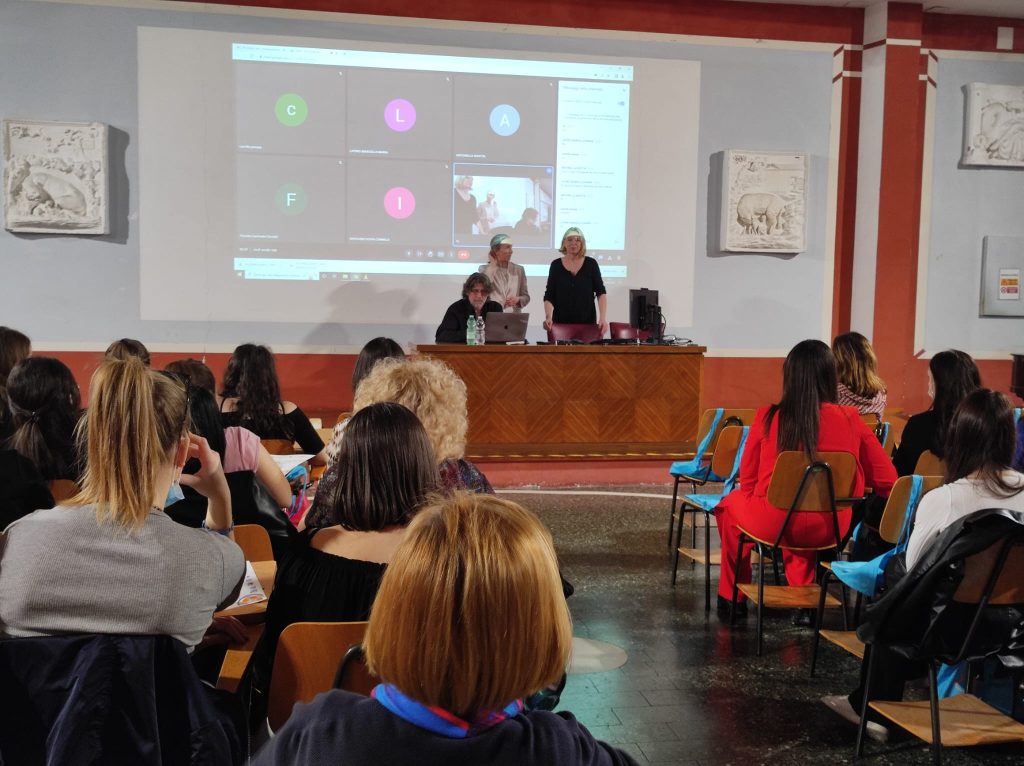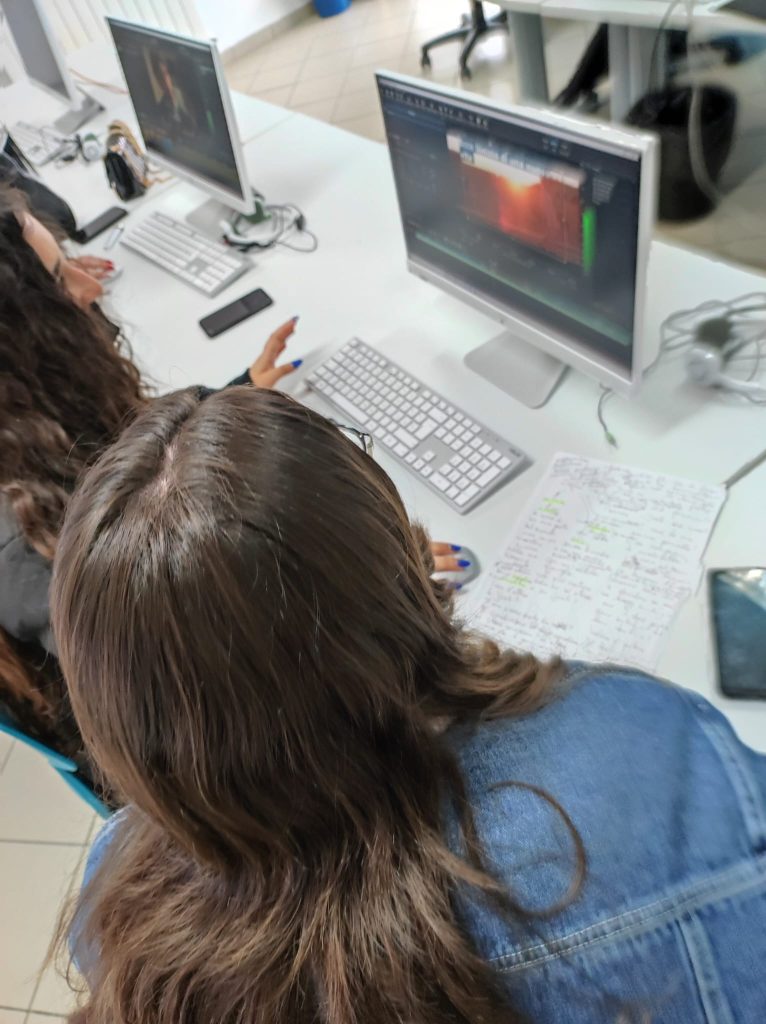A teenage girl stands on the brink of a rough, golden stone cliff face, shakily staring down to the blue-green depths far beneath her.[1]
She is in Sardinia, and the young man in the water below incites her to jump down and join him. After a moment of further hesitation, she awkwardly unpeels her cotton summer dress and underwear, and jumps the great height down to the waters beneath. We hold our breath as she skims down past the crumbling cliff-face, plunges underwater, and then returns safely to the surface, laughing. This sequence occurs towards the end of Francesco Fei’s teen film Mi chiedo quando ti mancherò (Wonder When You’ll Miss Me, 2019), and depicts a breakthrough moment of liberation for his heroine, from a past of body shaming, bullying, sexual assault, and a lack of self-confidence, which emerge as the key themes of the film.
I once made a jump of a similar height myself, in my early twenties, although it was off the Welsh coast on a grey spring day, and no number of hot men lurking in the water way below would have induced me to remove my full-body wetsuit. I was the only girl on an all-male trip that my partner at the time had convinced me I would enjoy, although it required jumping off cliffs and I have always been terrified of diving. The reason I finally jumped down into the dark, churning sea was not to keep up with the boys, but because the one female instructor on the trip told me I had to do it ‘for the girls’. When I hit the water my ears hurt. There was no epiphany. I wouldn’t do it again, but I’m glad I did it once.
In Mi chiedo quando ti mancherò, Amanda (Beatrice Grannò) jumps, but she doesn’t stay with the guy either. Without sliding into cliché, Fei’s film, adapted from the book by Amanda Davis, recounts the possibilities for self-discovery contained within the painful trials of adolescence in a fresh and subtle way. The film-makers had to keep schedules in synch with the real-life travelling circus that features at the heart of the film. Fei and his team also worked hard to film in Sardinia’s varied and evocative countryside, from glowing sandscapes to remote abandoned hotels. Their efforts paid off. They have created a vibrant and enticing, sometimes hostile, heterotopia for the heroine’s rite of passage, away from the oppression of school peer conformity, into adulthood.
The film was presented and screened by the director and its screenwriter, Chiara Barzini, at an event in May at La Sapienza University, Rome, to celebrate the achievements of over 70 Italian schoolgirls from our partner schools. They had participated in a video essay contest to share their views on recent Italian films and television about girlhood. Fei’s film was a fitting complement to the girls’ own views on cinema and television. In their video essays, they had privileged similar key themes. They had chosen films that explored the shame involved in inhabiting the female teenage body, and showed how girls get cornered by social structures of sexual or gendered subservience. However, they also selected films that showcase teen girls’ fêted resilience as they teeter on the cliff-edge of social expectation. The brief was for small groups of girls to use clips or images, together with voiceover, song and text to convey their personal response to a particular female protagonist. The participants chose from the list of films and television that we suggested here, which drew on some of the most popular, recent Italian representations of girlhood. Some of these video essays now feature on our website here, and more will follow.

The film most frequently chosen was Sul più bello (Out of My League, Filippi, 2020), a hybrid between the romantic comedy and ‘terminally-ill girl’ film, whose Netflix success was confirmed by the release of two follow-up films (Ancora più bello/Still Out of my League, 2021; Sempre più bello/Forever Our of my League, 2021). One third of participants chose this film, underscoring the popularity of the film’s heroine Marta (Ludovica Francesconi). Marta’s determination and strength dealing with cystic fibrosis and landing the man of her dreams is celebrated most creatively by our first prize-winners from the ISS Marisa Bellisario (here). Their video essay illustrates Marta’s appeal across ages and genders, including interviews with women of 40 and 73, and a male peer. It is important for young people to know that adults still experience insecurities too, as one of the interviewees in this video essay explains. The video essay echoes what director Antoneta Alamat Kusijanović says of her recent acclaimed Croatian film Murina (2021), about a 17-year-old diver and eel fisherwoman, ‘It’s very important that audiences, no matter who they are, no matter their age or sex, connect to the resilience that they had as young adults. I want them to leave the theater and say, I’ve been all of these characters in my life, but I remember the strength and resilience I had, and I love life.’[2] This talented video essay-making team underlines how important it is for young women to have products that target them, yes, but also to feel how a girl’s experience – being human – does not take place in isolation. So often, as one of our contest judges, Catherine O’Rawe has written, girls’ film fandom is marginalized and dismissed.[3] One goal of this contest is to bring girls’ spectatorship into mainstream discourse. Another way to achieve this might be through more shared, cross-gender, cross-generational viewings and discussions.
The popularity of the ‘terminally-ill girl’ film resonates with Jia Tolentino’s reading of Katniss Everdene in The Hunger Games, whose courage, she argues, ‘comes from her certainty that her future is a nightmare’.[4] What sense of (no) future haunts the recent popularity of films like Sul più bello, or Sulla stessa onda (Caught by a Wave, Camaiti, Netflix, 2021), another ‘terminally-ill girl’ film our students chose? What fears about global economic, political or climate catastrophe subtend these films’ obsession with premature death? A terror that the future will never arrive, so enjoy life now? Where is this terror more keenly felt than in the teenage years, when it seems like adulthood and its pleasures are always just out of reach?
Sul più bello begins with Marta telling us she has not blossomed into a swan, but remained an ugly duckling, speaking to disrupted temporalities and rebellious bodies. This quote features powerfully at the end of another video from the IIS Marisa Bellisario, winning 4th prize. Its inclusion in further video essays suggests how infrequently we see a female protagonist in Italian cinema and television who falls outside of traditional beauty canons.
Other video essays sharing joint first and fourth prizes addressed the teen female body that does not conform to expectations about body shape. To win first prize, students from the Liceo Scientifico Oberdan produced a lyrical voiceover to accompany images from the film Dolcissime (The Sweeties, Ghiaccio, 2019), another comedy, dealing with how three larger girls use friendship and synchronized swimming to overcome their ostracism. Picking up on the film’s resistance to ‘beauty culture’, the teen video makers observe how the difficulty of dealing with what we have inside makes us a society obsessed with the external self.

The theme in Dolcissime of obesity takes us full circle back to Mi chiedo quando ti mancherò. One of the most enigmatic conceits of this film is a second self (Claudia Marsicano) who accompanies Amanda on her travels, a previous, fatter self. This other self is a teen ‘unruly woman’, transgressive, flamboyant, inciting anger and violence, whom Amanda, empowered by her dive, will leave on the cliff tops of Sardinia.
The images that the video-essay makers from the Liceo Oberdan selected illustrate beautifully how the experience of being in water provides a weightless response to the burden of the girl in the mirror, bringing the body in its imperfection rather than leaving it behind. In these films, overcoming the fear of diving and drowning helps the girls to overcome their fear of social death through exclusion. Together, they are able to find strength in the water and re-emerge more confident. Essay-makers sharing 4th prize from the ISS Margherita di Savoia also focussed on Dolcissime, emphasizing, like those from the Liceo Oberdan, how this social exclusion operates most invasively through social media and its dictates about the female form. In their account the water, and the act of ‘holding one’s breath forever to escape life’ (‘una continua apnea per sfuggire la vita’), hint at the temptation to escape permanently from this nightmare.
Fiona Handyside and I have argued that European cinema repeatedly depicts girls in water as resilient, ‘purified and buoyed up by the water, [they] promise a world in which youthful femininity survives the threat of exploitation and economic instability.’[5] We might be cynical about continual incitements to girls to be strong, the girl standing in for the way Neoliberal governments conceive of their citizen-subjects, forced to draw on their own resources to survive.[6] By listening to and watching what teen girls quite literally make out of the fears of diving and dying that these tragi-comic films negotiate, we can understand more about how media intervene in experiences of body shaming, bullying, sexual assault, a lack of self-confidence, and anxiety about the future that plague female experience in adolescence and beyond.
This post has only explored a small number of the video essays submitted to our competition. In a subsequent post we will explore how other essays addressed the regional and social divisions of Italian girlhood. The teen-made video essay proves a significant resource in understanding how these audiences process film and television as part of their broader worldview. With this in mind, we will run the contest again next year, expanding its reach to new schools so that we can explore further what girls like, and don’t like, about Italian cinema and television, particularly in relation to gender. In turn, through participation in major film festivals, we will begin to share our findings with stakeholders in the film and television industry, fostering debate about how girls’ stories could be told differently, and what stories remain to be told.
Thanks:
Thanks to all our wonderful student participants and their supportive teachers and schools! We will address the 2nd and 3rd prize-winners, and some of the other video essays entered in subsequent posts. A particular thanks to our dedicated panel of judges: Fabrizia Midulla, Emiliano Morreale, Federica Nicchiarelli, Varinia Nozzoli, and Catherine O’Rawe and Chiara Salvo, and to the students of the Istituto E. Falck for recording and photographing the event.
[1] Thanks to Maria Elena Alampi and Dominic Barth for comments on earlier drafts of this post.
[2] ‘Murina’ Trailer: Martin Scorsese Exec Produces Camera d’Or Winner | IndieWire
[3] Catherine O’Rawe, Stardom and Masculinities in Contemporary Italian Cinema (Palgrave, 2014)
[4] Jia Tolentino, ‘Pure Heroines’ in Trick Mirror: Reflections on Self-Delusion (4th Estate, 2019), p. 110.
[5] Danielle Hipkins and Fiona Handyside, ‘The Ebbs and Flows of Girlhood Experience across European cinema’ in The Routledge Companion to European Cinema ed. by Gábor Gergely and Susan Hayward, (Oxford: Routledge, 2022)












